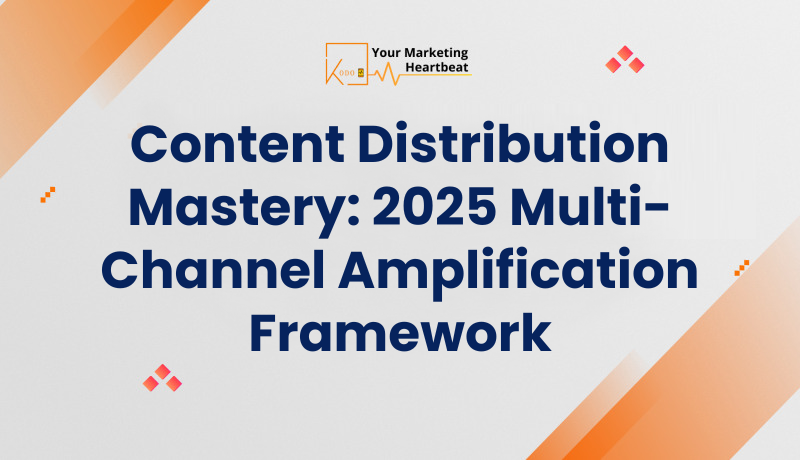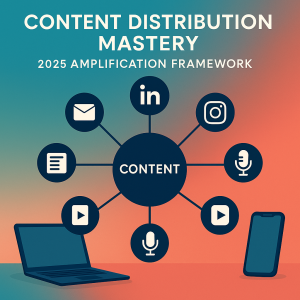
Content Distribution Mastery: 2025 Multi-Channel Amplification Framework
In today’s digital landscape, the sheer volume of content available can be overwhelming. As marketers, we face the challenge of ensuring our messages cut through the noise and reach our target audiences effectively. The key to achieving this lies in mastering a robust content distribution strategy that leverages multiple channels. This article will explore the essential components of a successful multi-channel distribution framework for 2025, focusing on cross-platform syndication, content atomization, and reach optimization.
Understanding the Importance of Multi-Channel Distribution
The Changing Landscape of Content Consumption
The way consumers engage with content has evolved dramatically. Gone are the days when a single blog post or social media update could suffice. Today, audiences are spread across various platforms, each with unique characteristics and user behaviors. To effectively connect with our audience, we must be present where they are, whether that’s on social media, email, podcasts, or other digital touchpoints.
The Need for Strategic Distribution
Simply creating high-quality content is not enough. We must also focus on how we distribute that content. A well-crafted distribution strategy ensures that our messages reach the right people at the right time. This involves understanding the nuances of each platform and tailoring our approach accordingly.

Benefits of a Multi-Channel Approach
Adopting a multi-channel distribution strategy offers several advantages:
- Increased Visibility: By being present on multiple platforms, we enhance our chances of being discovered by potential customers.
- Enhanced Engagement: Different platforms cater to different audience preferences. By diversifying our content formats, we can engage users more effectively.
- Improved Brand Credibility: A consistent presence across various channels builds trust and authority in our brand.
Key Components of a Successful Content Distribution Strategy
1. Audience Understanding
To create an effective distribution strategy, we must first understand our audience. This involves:
- Creating Detailed Buyer Personas: Identify who our target customers are, their preferences, and where they spend their time online.
- Utilizing Analytics Tools: Leverage tools like Google Analytics and social media insights to gather data on audience behavior and engagement patterns.
2. Content Atomization
Content atomization refers to breaking down larger pieces of content into smaller, more digestible formats. This allows us to maximize the reach of our content across various platforms. Here’s how to implement it:
- Identify Core Content: Start with a comprehensive piece, such as a blog post or whitepaper.
- Create Multiple Formats: Transform the core content into various formats, such as infographics, videos, social media posts, and podcasts.
- Distribute Across Channels: Share these formats on the platforms where your audience is most active.
3. Cross-Platform Syndication
Cross-platform syndication involves sharing content across multiple channels to increase visibility. This can be achieved through:
- Social Media Sharing: Post content on platforms like Facebook, Twitter, LinkedIn, and Instagram, tailoring the message for each audience.
- Email Marketing: Use newsletters to share valuable content and drive traffic back to your website.
- Partnerships and Collaborations: Collaborate with influencers or other brands to reach new audiences through guest posts or co-created content.
4. Reach Optimization
To ensure our content reaches the intended audience, we must optimize our distribution efforts. This includes:
- SEO Best Practices: Implementing SEO strategies to improve organic visibility on search engines.
- Paid Advertising: Utilizing targeted ads on social media and search engines to amplify reach.
- Timing and Frequency: Analyzing data to determine the best times to post content for maximum engagement.
Crafting a Multi-Channel Distribution Plan
Step 1: Set Clear Goals
Before diving into distribution, we must establish clear, measurable goals. These could include:
- Increasing website traffic by a certain percentage.
- Growing social media followers or engagement rates.
- Generating leads through email sign-ups or downloads.
Step 2: Identify Key Channels
Based on our audience research, we should identify the most effective channels for distribution. This may include:
- Social Media Platforms: Determine which platforms align with our audience demographics.
- Email Marketing: Segment our email list to tailor messages for different audience groups.
- Content Sharing Sites: Explore platforms like Medium or LinkedIn for additional exposure.
Step 3: Create a Content Calendar
A content calendar helps us plan and organize our distribution efforts. It should include:
- Content Types: Specify what types of content will be shared on each platform.
- Posting Schedule: Outline when and how often content will be posted.
- Performance Metrics: Define how success will be measured for each piece of content.
Step 4: Monitor and Adjust
Once our distribution plan is in motion, we must continuously monitor its performance. This involves:
- Analyzing Engagement Metrics: Track likes, shares, comments, and click-through rates to gauge effectiveness.
- A/B Testing: Experiment with different content formats, headlines, and posting times to optimize results.
- Adjusting Strategies: Be prepared to pivot based on what the data reveals about audience preferences.
Overcoming Common Challenges in Multi-Channel Distribution
1. Content Overload
With so much content available, it can be challenging to stand out. To combat this, we should focus on:
- Quality Over Quantity: Prioritize creating high-quality, valuable content that resonates with our audience.
- Unique Value Proposition: Clearly communicate what sets our content apart from competitors.
2. Platform-Specific Nuances
Each platform has its own rules and best practices. To navigate this, we should:
- Tailor Content for Each Platform: Adapt our messaging and format to suit the unique characteristics of each channel.
- Stay Updated on Trends: Regularly research platform updates and trends to ensure our strategies remain relevant.
3. Resource Limitations
Many businesses face resource constraints when it comes to content creation and distribution. To address this, we can:
- Repurpose Existing Content: Maximize the value of our current content by repurposing it for different formats and channels.
- Leverage Automation Tools: Utilize tools for scheduling posts and analyzing performance to streamline efforts.
Conclusion: Embracing the Future of Content Distribution
As we move into 2025, mastering a multi-channel content distribution strategy will be essential for success. By understanding our audience, leveraging content atomization, and optimizing our reach through cross-platform syndication, we can ensure our messages resonate with the right people at the right time.
The digital landscape is ever-evolving, and staying ahead requires adaptability and a commitment to continuous learning. By implementing the strategies outlined in this article, we can build a robust content distribution framework that not only enhances visibility but also fosters meaningful connections with our audience.
Are you ready to elevate your content distribution strategy? Let’s embrace the future together and make our mark in the digital world!
